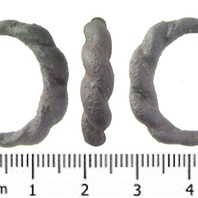
Viking Objects
Copper-Alloy Finger-Ring (SWYOR-AA27B1)
This copper-alloy finger-ring seems as if it was made from two strands of twisted wire, but could possibly have been cast. The ropework hoop may have been gilded. Even though similar designs are known from the Viking period, they were also used in other periods as well. Hence, the large date range.
Read More
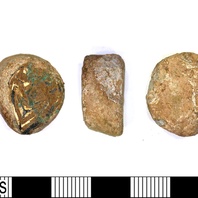
Viking Objects
Gilded Lead-Alloy Weight (LEIC-C6C96A)
The inset decoration of this weight is probably a reused fragment of an Irish or Anglo-Saxon object. Its importation and re-working is likely the result of Viking intervention. The distinction of weights by embedded objects or other embellishments in various media is a widely recognised feature of some early medieval weights. Weights are an important form of evidence for Viking Age commerce and the use of standards across the different economic systems within which Vikings were integrated. Many of the weights discovered, particularly ones in Ireland and those of Arabic type, suggest that a standardized system of weights existed in some areas. These standard weights, alongside standard values of silver, are what allowed the bullion economy of Viking-occupied areas to function. A bullion economy was a barter economy that relied on the exchange of set amounts of precious metal in various forms, such as arm-rings or coins, for tradeable goods, such as food or textiles. Each merchant would have brought their own set of weights and scales to a transaction to make sure that the trade was conducted fairly.
Read More
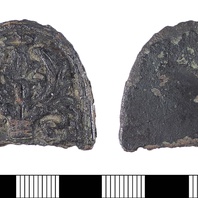
Viking Objects
Carolingian-Style Strap-End (LIN-9A2879)
It has been suggested this this strap-end came from a sword harness and, therefore, is classed as Thomas’s Class E, Type 1. The strap-end bears Carolingian-style relief decoration of a palmette set within a stylised plant with acanthus foliage and brush-like leaves. It does now show any evidence of gilding. Carolingian belt fittings from England could have been imported either indirectly through Scandinavia or directly from the Continent. It is possible that this strap end was brought over by Scandinavians as a result of their raids on the continent. Gabor Thomas suggests that the localisation of similar types of strap ends, known as Aspatria-type, in the Irish Sea region could indicate that they were worn by Scandinavian communities in that area.
Read More
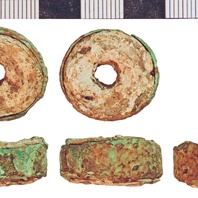
Viking Objects
Copper-Alloy Edged Lead Weight (NLM-E6E083)
A lead weight edged with a copper-alloy band. The distinction of weights by embedded objects or other embellishments in various media is a widely recognised feature of some early medieval weights. The object has also been identified as a spindle whorl, though this is less likely. If a weight, it is perhaps an indicator of the Scandinavian bullion economy. Weights are an important form of evidence for Viking Age commerce and the use of standards across the different economic systems within which Vikings were integrated. Many of the weights discovered, particularly ones in Ireland and those of Arabic type, suggest that a standardized system of weights existed in some areas. These standard weights, alongside standard values of silver, are what allowed the bullion economy of Viking occupied areas to function. A bullion economy was a barter economy that relied on the exchange of set amounts of precious metal in various forms, such as arm-rings or coins, for tradable goods, such as food or textiles. Each merchant would have brought their own set of weights and scales to a transaction to make sure that the trade was conducted fairly.
Read More
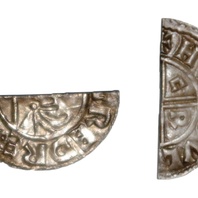
Viking Objects
Aethelred II Penny (LIN-8887C3)
A cut CRUX-type penny minted by Hundulf of York on behalf of King Aethelred II. While this coin is Anglo-Saxon, the fact that it has been cut may suggest that it was used as a part of a bullion transaction in line with the dual bullion-monetary economy established by the Vikings in England.
Read More
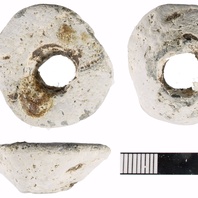
Viking Objects
Lead Spindle-Whorl (NLM-1E7FD8)
This cast lead spindle-whorl is classed as a Walton Rogers A1 type and, due to its mass, it was likely used for spinning yarn. Fibres were spun into thread using a drop-spindle of which the whorls were made of bone, ceramic, lead or stone and acted as flywheels during spinning.
